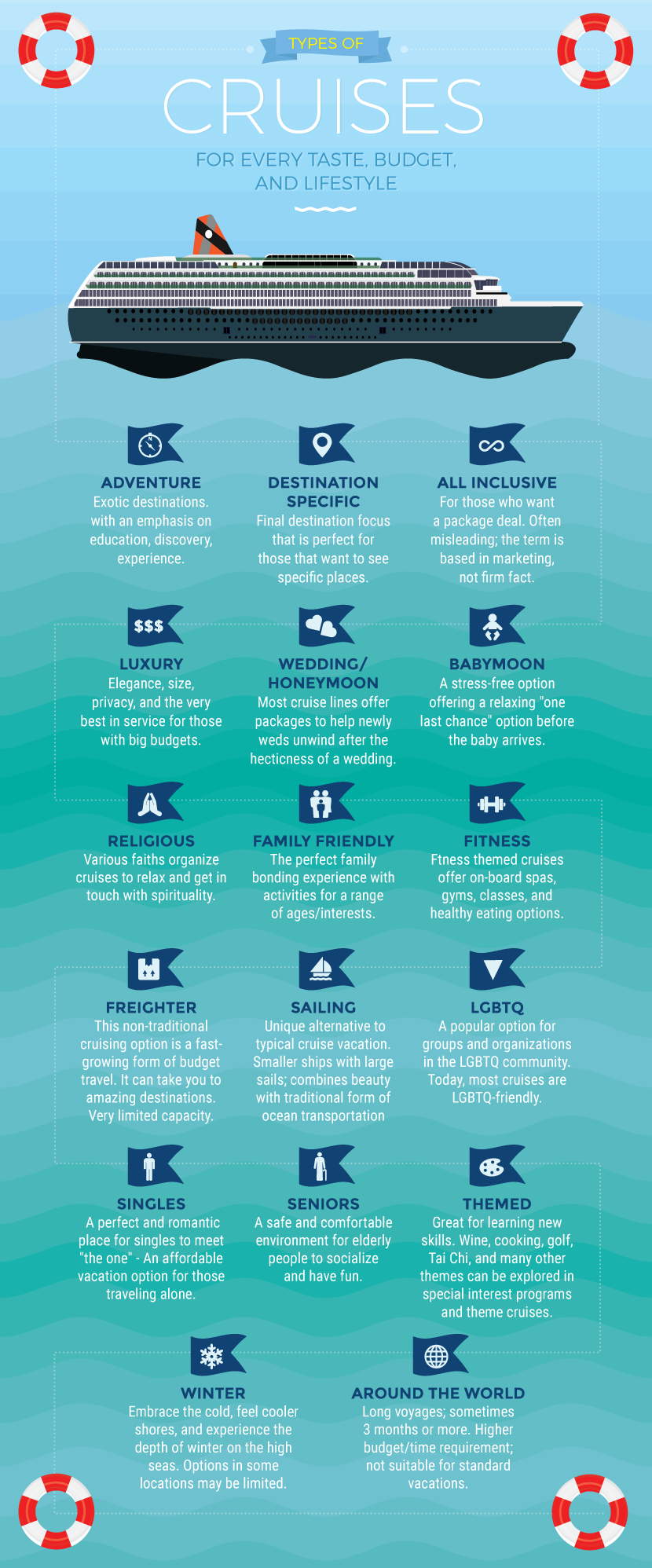Cruise Tips from Planning to Port
Pick the Right Cruise For You
A cruise is a great way to enjoy multiple destinations while only unpacking once.
Cruisers combine the convenience of an all-inclusive resort with the adventure of ports of call and international experiences.
However, planning a cruise involves a special set of considerations that planning your average trip does not. How will you get to your departure port? Should you book excursions ahead of time?
What does your ship include in the fare? Here’s what you need to know to plan the perfect cruise, whether it’s a luxury or budget, tropical or adventurous trip.

What Type of Cruiser do You Want to be?
The first decision to make in the cruise planning process is to pick the type of cruise that’s best for you.
If budget is a primary factor, a large, budget cruise ship will work nicely. Most sail for 5–7 days to the Caribbean, Bahamas, Mexico, Central America, and Alaska.
Large cruise ships mean bigger crowds but they offer more onboard amenities, like multiple restaurants, pools, rock-climbing walls, and bigger gyms and spas.
If budget is not a concern but onboard amenities are still important, opt for a mid-sized luxury ship,
which will be more personalized with great service and (usually) true all-inclusiveness, with drinks and exercise classes included in your fare.
If unique ports of call and an active itinerary are more important to you than onboard amenities, consider a small cruise ship.
These ships, which hold fewer than 200 passengers in most cases, are highly personalized, and they can stop at smaller ports off the beaten path.
Many small cruise ships include daily opportunities to snorkel, kayak, hike, and photograph wildlife, but they will cost more than traditional cruises.

Once you’ve decided on the type of cruising that works for you, it’s time to pick a cruise line.
Compare lines by looking at their destination ports (where do you want to leave from?),
the itineraries they offer (this is where you’ll choose between tropical cruises, Alaskan cruises,
and European cruises, for instance), and their levels of inclusiveness.
Note that while virtually all cruise lines include room and board in their fares, some are truly all-inclusive, including alcohol, all excursions, and activities.
Most charge extra for drinks, some onboard activities, and all excursions. Almost all lines prohibit bringing your own liquor or beer onboard, though most allow up to two bottles of wine.
Ships store wine and liquor purchased at ports until disembarkation.
Cruise lines that do not include alcohol in their cruise fares offer alcohol packages; do the math to determine whether such a package makes sense for you.
Planning Your Cruise Transportation and Getting Settled
Once you’ve settled on a cruise, it’s time to figure out how you’ll get to your embarkation port.
One thing all cruises have in common is that they will leave without you.
Therefore, plan to arrive the day before your departure if you’re flying to your port and plan to arrive several hours before boarding time if driving.
You can even plan to drive the day before and stay the night at a port-side hotel
(many will allow you to park your car there instead of at the port for less money).
If you’re flying to your port, look for a pre-cruise hotel that offers a shuttle service to your cruise or that is within an easy Uber fare.
Check in online before you arrive to the port for ease of boarding; almost all cruise lines offer this service.
Be sure to bring the paperwork that your cruise line requires, including your passport.
Most cruise lines allow you to start the embarkation process by 11:30 am on the day of departure,
which gives passengers time to eat a leisurely lunch while waiting for their staterooms to be ready.
Tip: Pack a day bag with swimsuits and essentials so you don’t have to wait for your bag to be delivered before enjoying the pool.
Consider booking a massage or other spa service for your embarkation day to get you into “cruise mode.” These services are usually discounted on the first day.

Making the Most of Cruise Excursions
While onboard amenities are fun, you probably aren’t going on a cruise just to stay on the ship at every port.
To avoid long lines at guest services during your cruise, book your excursions online before departure if you’re booking them through the cruise line.
If you’re booking excursions independently, plan to book them for mid-morning on your days in port since many large cruise ships give priority disembarkation to passengers booked on cruise-specific excursions.
Booking independently has its perks, however – you’ll usually save some money, you’ll help the local economy by paying tour operators directly, and you’ll avoid crowds of cruise passengers.
To find safe, reputable excursions on your own, contact the local tourism board before your trip and make arrangements with verified businesses ahead of time.
However, it’s important to remember the first rule of cruising: your cruise WILL leave without you if you’re not back on time.
If your ship has limited time at a port (under 6–8 hours), it’s usually safest to book official cruise line excursions that guarantee your prompt return to the ship.
Planning to Disembark
At the end of your cruise, you’ll likely have an early-morning disembarkation.
The process is known to go slowly since all passengers need to go through customs,
but you can make it go faster by hanging onto your carry-on luggage (instead of putting it out the night before).
Have your paperwork ready, and schedule a late-afternoon or evening flight home to be on the safe side.
Embed the article on your site

